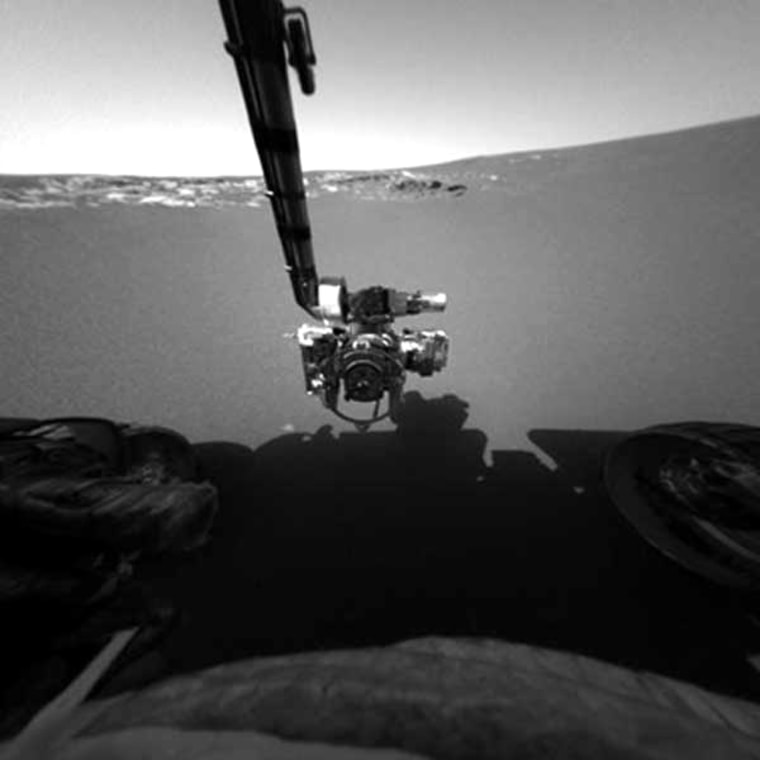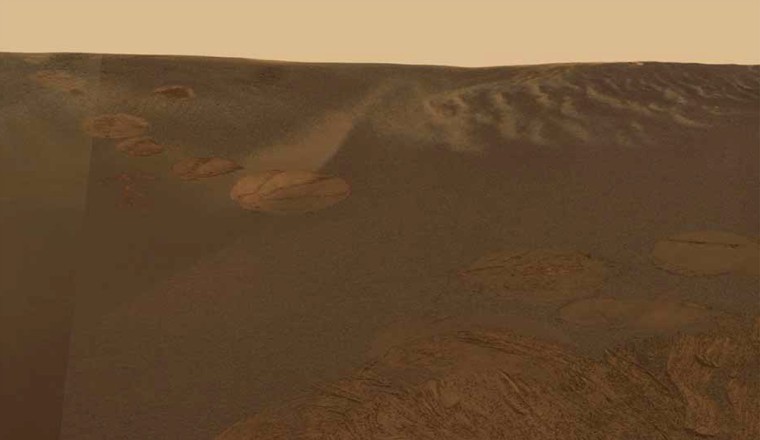NASA’s Opportunity and Spirit rovers reached out their robotic arms to touch the surface of Mars on Monday, marking the first day of the joint $820 million mission that both spacecraft were in full swing.
On Jan. 21, Spirit suffered a computer glitch that took more than a week to fix — and engineers still aren't quite done with their repairs. They plan to reformat Spirit's flash memory on Tuesday, during the next Martian day, or sol. But in the meantime, Spirit has resumed its analysis of Adirondack, the rock it was studying when the computer problem cropped up.
"Today we are doing science on Spirit, just like we were about 10 sols ago," mission manager Jennifer Trosper told journalists at NASA's Jet Propulsion Laboratory in Pasadena.
NASA planned for Spirit to brush the dust off Adirondack, allowing the rover’s microscopic imager to photograph it in extreme close-up. Then the rover would use its rock abrasion tool to grind into the rock surface and do some further analysis.
Mission managers say it may be a few more days before Spirit rolls off to its next target.
'You are there'
While Spirit continues its work on Adirondack in Mars' Gusev Crater, Opportunity is surveying its surroundings within a 65-foot-wide (20-meter-wide) crater in Meridiani Planum. On Monday, the mission team unveiled Opportunity's first 360-degree color panoramic image, showing a wide expanse of brick-red soil and lighter bedrock outcroppings, with glimpses over the crater edge to the plain beyond.

“It provides us with a real sense of you are there,” said Jeff Johnson, of the U.S. Geological Survey. But he said the panorama was more than just a pretty picture: By looking at the view through different color filters, scientists can learn more about the composition of the soil and rocks in the picture. Initial findings indicate that the soil inside the crater is much like the soil outside the crater, Johnson said.
Opportunity’s robotic arm includes several instruments that can be used to study materials found on the planet’s surface. Engineer Joe Melko said photographs showed that all the pieces of the arm are in place.
“The arm is working well,” he said.
Over the next day, scientists plan to use Opportunity's suite of instruments for an up-close soil analysis. Opportunity already has spied a mineral called gray hematite in the soil. Preliminary evidence suggests the iron-rich mineral is of a variety that forms in liquid water, providing the first, best evidence that the site may have been wetter and more hospitable to life long ago.
Extended mission
Team members said they were pleased with the science return so far, less than a month into the mission on Mars. Spirit landed on Jan. 3, while Opportunity touched down Jan. 24.
Engineers believe at least one and maybe both of the 384-pound (175-kilogram) robots may last at least twice as long as their planned 90-day lifetimes. A 15-watt heater that’s been turning on unnecessarily on Opportunity may curtail its extended mission, however.
Once under way, the two six-wheeled rovers could cover thousands of yards apiece, rolling from target to target like no other mission to Mars ever has.
NASA scientists said the two solar-powered spacecraft have ample time to roam far and wide across the very different locations into which NASA plopped them.
“With the duration these missions are going to have, with the scientific riches at each site, the best is still ahead of us,” Cornell University astronomer Steve Squyres, the mission’s main scientist, said in a recent interview.
The $820 million twin-rover mission is aimed at studying Mars' geologic history and determining whether liquid water flowed on the planet in ancient times long enough to allow life to develop. If liquid water persisted on Mars, astrobiologists say that would better the odds for finding traces of life.
